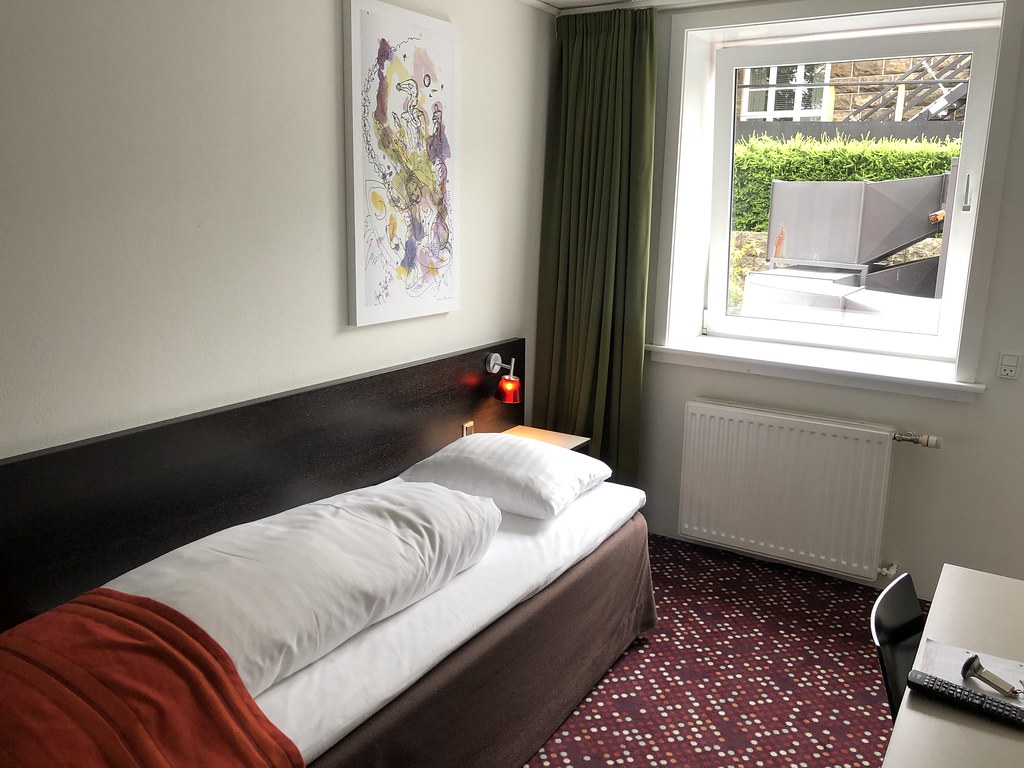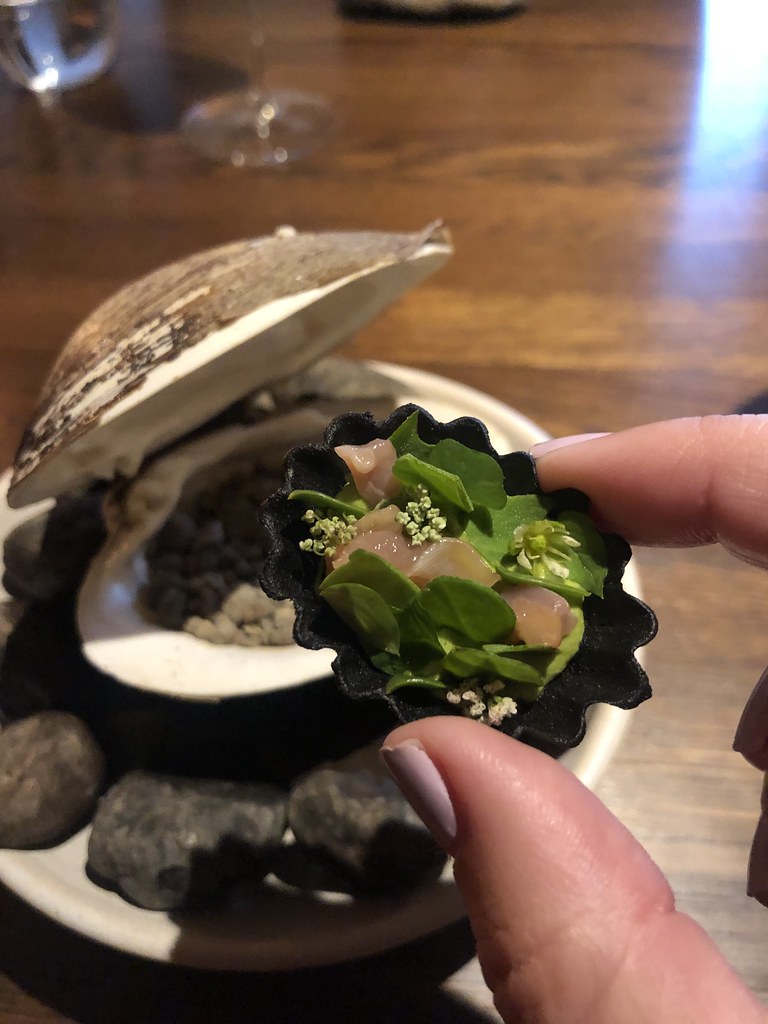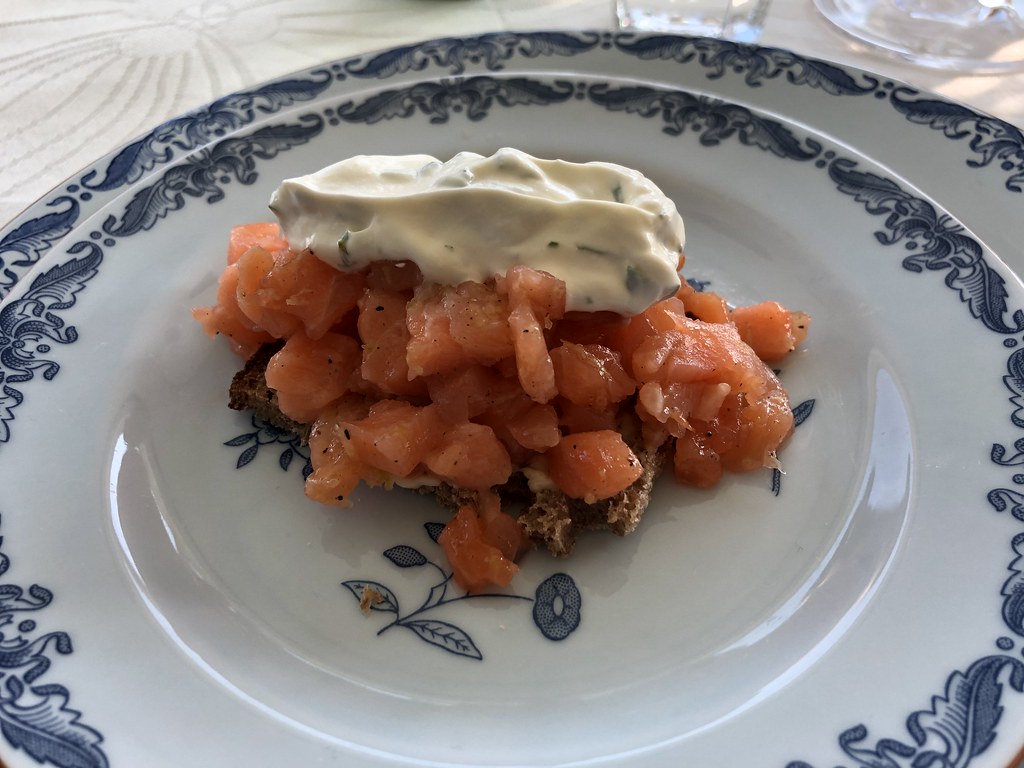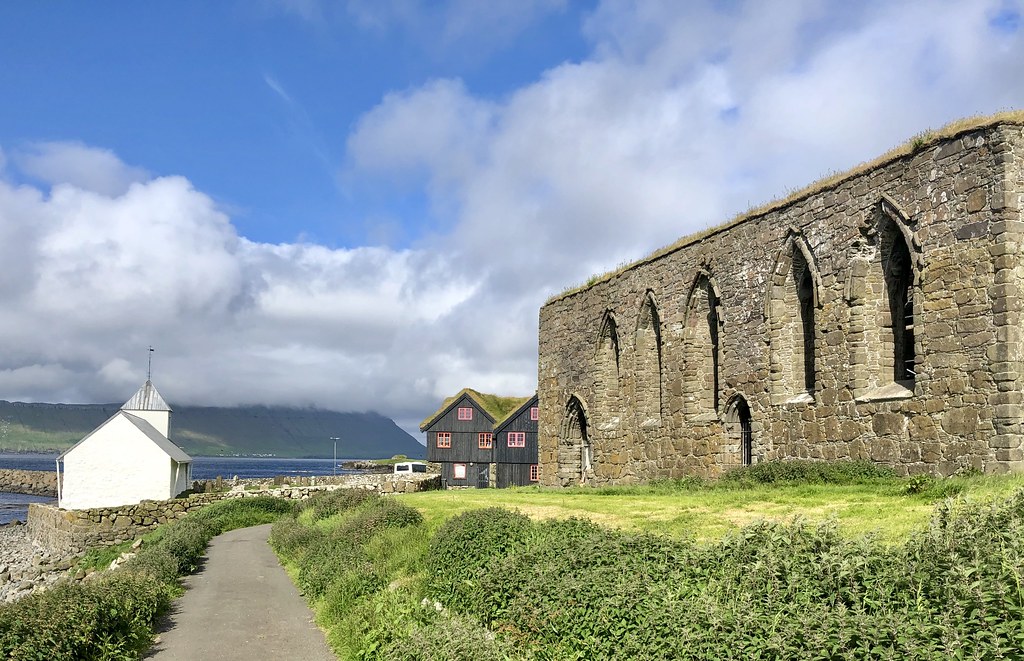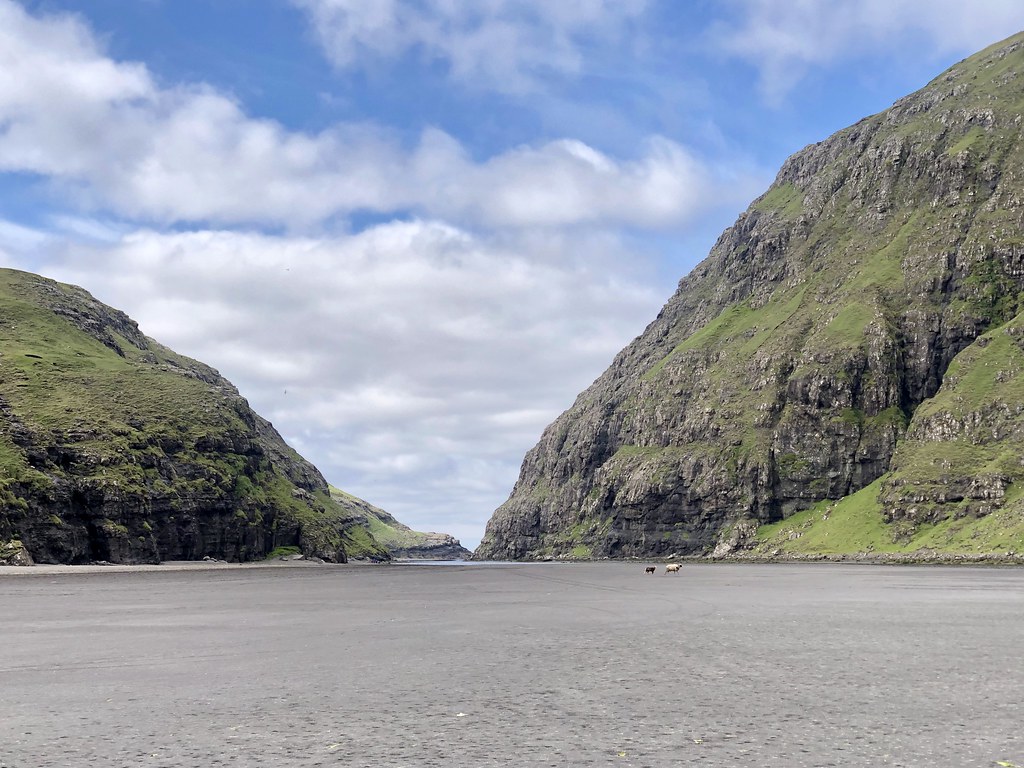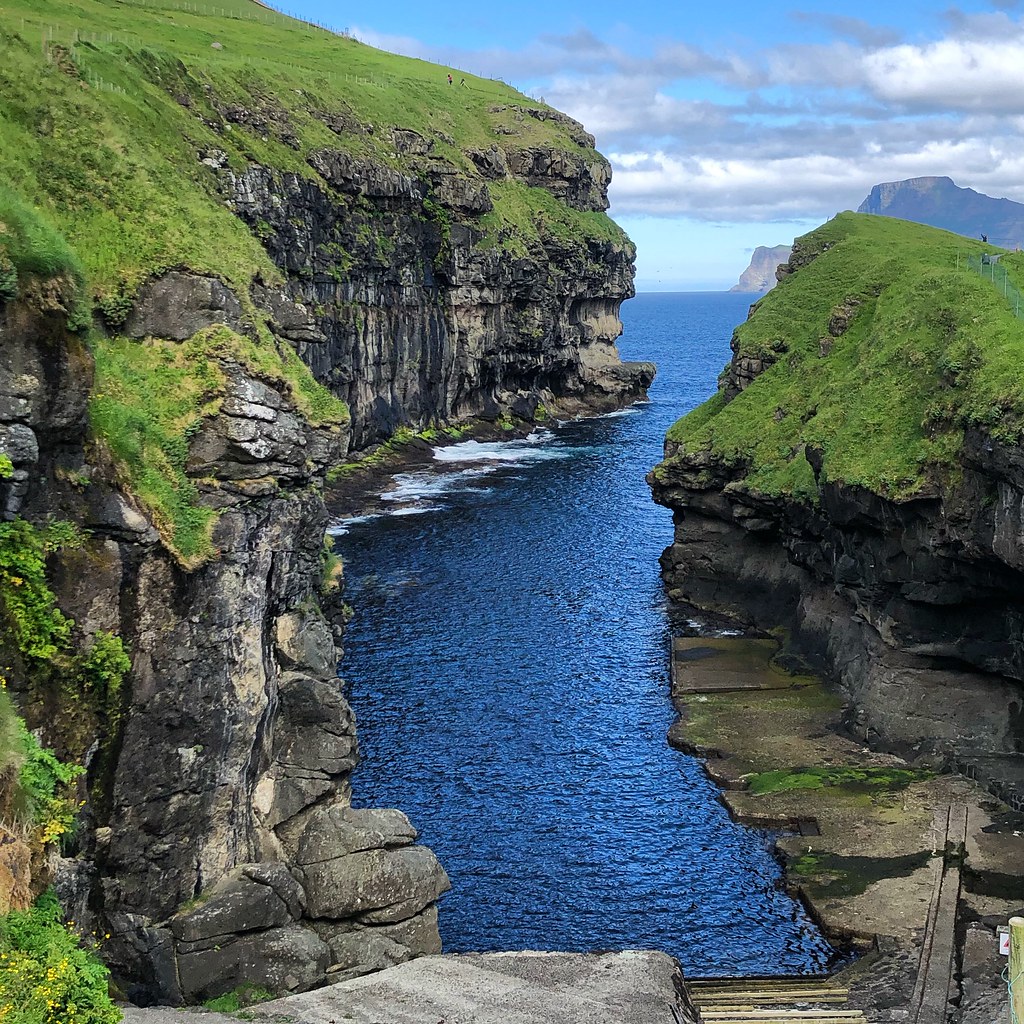Aaron and I were staying in the capital city of Tórshavn on Streymoy during our visit to the Faroe Islands. It's a cute harbor town that dates from the late 1500s with a population of about 20,000.
We each booked a single room at the Hotel Tórshavn (they have 43 rooms of various sizes) which is a moderate hotel right in the middle of town.
The rooms are basic but roomy, breakfast was included, and there was free parking in the connected lot. Large windows filled the small room with light and artwork from local artist Rannvah Mortensen decorates the walls of most the guestrooms. The hotel was a great choice for us and the staff was absolutely fantastic!
On our very first night on the islands we had reservations at the 2-starred Michelin restaurant KOKS. From the very start we knew we were in for a pretty unique dinner. Aaron had arranged for a taxi which took us out to the shore of Lake Leynavatn about 20 minutes outside of Tórshavn.
I was really confused when he dropped us off as there was nothing but a small shed on the muddy lake bank. A vintage Land Rover was parked along the beach. We were invited inside the hjallur (an old fish drying shed) and offered beer and snacks. There were 4 other diners and we were all ushered into the back of the Rover after our "happy hour".
We arrived at our destination, with the team of KOKS greeting us as we entered the turf-roofed farmhouse, in the middle of nowhere. A fire was going in the yard and sheep could be heard bleating from the hills.
There are 9 chefs at the restaurant, each from a different country in order to lend a worldwide approach to the local seafood and vegetables that are foraged from the islands. Traditionally the Faroese eat only fish, sheep, and whale so by bringing in chefs from around the world, they are able to introduce preparations for local delicacies like mussels, langoustine, and sea urchin.
The farmhouse is incredibly cozy inside, with blond wood paneled walls, sheepskin throws on chairs and benches, and windows looking out onto the green hills. We were seated at our table, which was then adorned with a huge plate of fresh shellfish; a peek at the raw ingredients that would soon be dinner.
The multi-course meal started with a progression of mainly shellfish, which unfortunately Aaron doesn't eat. I loved my dishes of scallops, clam, sea urchin, mussels, and langoustines; each presented in the shells they naturally live in. But Aaron was served some basic, although pretty, mostly vegetable substitutions. It didn't seem to be of the same calibre. It was the only disappointment of the evening.
Mid menu highlights finfish, the halibut with caviar being a natural favorite for us two caviar lovers, followed by ræst. Ræst is another traditional Faroese style of preserving food. Lamb or fish is hung to dry in small sheds that are built with slatted walls, allowing the salt air to flow through and dry/ferment the meat.
Our server presented us the dried leg of lamb, similar to a leg of prosciutto, before we were served it two ways. The first, called Skerpikøt, literally means sharp meat. A thin piece was carved off and served with a creamy sauce containing lingonberry.
We were also served the fermented lamb roasted with sweet onions in a delicious broth. And to round out our lamb courses was a small dish of garnatálg, or lamb tallow, served with crispy little biscuits to be spread on. And by the way, all of this was very tasty!!
As I mentioned, pilot whale has been and continues to be a staple of Faroese cuisine. Whaling is also a communal event, with all participants sharing in the meat. You can read more about legal, sustainable whaling in the Faroe Islands here while you look at the whale heart dish we had.
We took a little break after dinner and had a tour of the tiny kitchen as well as the outside grill area. A separate small building acts as the pantry and there is a communal table outside for family meal. The setting could not be prettier.
Back inside we finished our dessert of sweet wafers with jam and whipped cream in the super hygge "lounge". Our server let us know that the Land Rover was ready to take us back to the drop off where our taxi would be waiting. We'd spent about 5-hours at the restaurant and it was just about 11:30pm.
KOKS offers a 17-course tasting menu for about $260, wine pairings are another $200 so this isn't your run of the mill Wednesday night dinner. But it is a wonderful destination experience, really unlike any other I've experienced, and one I'd highly recommend!
The other completely unique dining experience I had was to attend a heimablídni, which means home hospitality. Our hosts Anna and Óli have a beautiful house and sheep farm near Tórshavn; we were 2 of 14 who attended their dinner party.
Our evening started with our taxi dropping us off at their modern turf-roofed home with sweeping views of the ocean and the nearby islands of Koltur and Hestur. Óli met us in the driveway, bearing a tray of house-made lamb sausage and a lemonade sort of drink.
After our snack we piled into cars (Aaron and I got a ride from some others) and followed Óli to the family's sheep farm. He introduced us to his young Faroese sheepdog and explained that he was still training her and he had others who were more senior.
His land stretches as far as you can see into the hills. When he sent the dog out to bring the sheep in we couldn't even see her some of the time, she had to run so far! It was a really fun demonstration in a stunning location.
We headed back to the house where Anna was hard at work on our meal. The table looked absolutely lovely! Other guests had arrived and we all had a drink outside before sitting down to dinner.
Over five courses we got to hear about the other guests (for example, three had flown in from the Shetland Islands for the dinner and another was a reporter) and learn about Anna and Óli's life on the islands and the farm.
And of course we had some excellent food! Anna is a fantastic chef and they use ingredients mainly from their farm or from local fisherman. Local beer was also served.
The dinner costs about $165 and you must sign up in advance. I thought it was a great value as you really get a chance to learn about local customs, traditions, and their history.
Plus cute animals, delish food, fun people, and amazing views! When we were leaving I said to Óli, "You know what I really liked about tonight?" and he replied "You liked everything!" And he was exactly right. I LOVED this experience!
Without a doubt we had the two top meal experiences on the Faroe Islands. But we did also eat at some regular restaurants in Tórshavn. Etika Sushi sounded promising and we were both looking forward to having some regional fish that we might not get at home.
Unfortunately it was the same fish you would get anywhere, and the sushi was put together very sloppily. The menu was also overly confusing to the point where we both accidently ordered too much. It was fine but I wouldn't go out of my way.
We also had dinner one evening at Barbara Fishhouse which is tucked in the Reyn area of the city. This is the oldest neighborhood with homes dating from the 14th century. It's adorable!
The food at Barbara is served tapas style, lots of delicious shareable dishes. The menu is heavy on shellfish though, which was fine for me but not so great for Aaron.
Wandering the cute city on multiple occasions, it was easy to stop for a glass of wine and sit outside to enjoy the view of the harbor.
And besides the neighborhood of Reyn, it is very easy to walk through Tinganes. This area from the Viking Ages was the parliament or government meeting space for the islands. The first meeting was held here in 825 and is believed to be one of the oldest in the world.
Most of the buildings have been rebuilt due to fire, but there are still some carvings and parts of buildings that are original.
We never found a proper cocktail bar in town, but I had Marlin & Joel behind the bar at the Hotel Tórshavn mixing me great martinis so I was happy! And on our last night at the hotel there was live music on in the bar, and most of the town's residents seemed to be in attendance!
Aaron and I had a crazy early flight the next morning so I checked us out the night before. The front desk person was so nice and offered to have coffee and croissants put out for our 5:45am departure. Really, the service at the hotel was always awesome!
It was beautiful as we left Tórshavn but the fog was incredibly thick on the way to the airport which meant we were at just about a crawl for the first 20 minutes of our 45 minute drive. And then, being that it was the crack of dawn, the gas station was closed!
At the airport the rental office wasn't open! It's not like they don't know the only 2 flights a day. So I dropped the keys off with the airport Information Desk guy and hoped for the best.
The Faroe Islands are truly and amazing place to visit! And delicious!
**Thank you to the Hotel Tórshavn who provided me with complimentary night stays! However all opinions are my own**
All photos from the Faroe Islands here.
Other posts from this trip:

